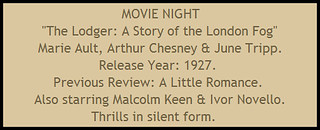

Review #963: The Lodger: A Story of the London Fog.
Cast:
Marie Ault (The Landlady - Mrs. Bunting), Arthur Chesney (Her Husband - Mr. Bunting), June Tripp (Daisy Bunting, a Model), Malcolm Keen (Joe Chandler), and Ivor Novello (Jonathan Drew - The Lodger) Directed by Alfred Hitchcock (#219 - Rope, #223 - North by Northwest, #446 - Spellbound, #447 - Psycho, #450 - Vertigo, #455 - Rear Window, #553 - Strangers on a Train, #800 - Shadow of a Doubt, and #910 - Notorious)
Review:
This was the third Hitchcock film (with the other two being The Pleasure Garden and The Mountain Eagle), and it is also considered one of the first thriller films, with this one based on a novel of the same name by Marie Adelaide Belloc Lowndes and the play Who Is He? by Horace Annesley; this is also the first time I've covered one of his silent films, of which he made nine, all in the 1920s. In any case, this is a first rate thriller, managing to have a good deal of style and suspense that works at making this a neat classic. The color tinting along with the shots the editing (done by Ivor Montagu, who also suggested the reduction of title cards) also help in giving the movie an interesting look (one particularly memorable shot being To-Night Golden Curls, which is shown a few times during the film); the shot of Novello's introduction is also a nice shot, with his appearance and the way the shadows and figures are shot making for an interesting introduction of the title character. Novello certainly has an interesting performance, balancing quirky (and somewhat suspicious nature) and his chemistry with Tripp into a fairly entertaining performance for a movie verging on the suspense of who the killer could be. Ault and Chesney do fine jobs as well. Keen also does a decent job, particularly in his scenes with Novello and Tripp near the end (although one highlight is him cutting out cookie dough in the shape of a heart). One scene in particular stands out, with an edit of his feet pacing on the room above the others being a great image to watch. The film definitely has its moments of using imagery or its actors to carry the film, with the climax (and the nature of the town mob) being quite fitting. The movie reaches on levels that Hitchcock would cover in many of his other films throughout his career, from the nature of the kill to the innocent man; on the whole, this is a fairly crafted film that proved to be the spark of his career.
Overall, I give it 9 out of 10 stars.

No comments:
Post a Comment